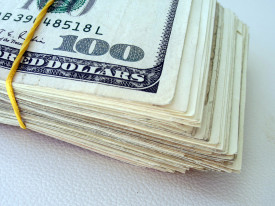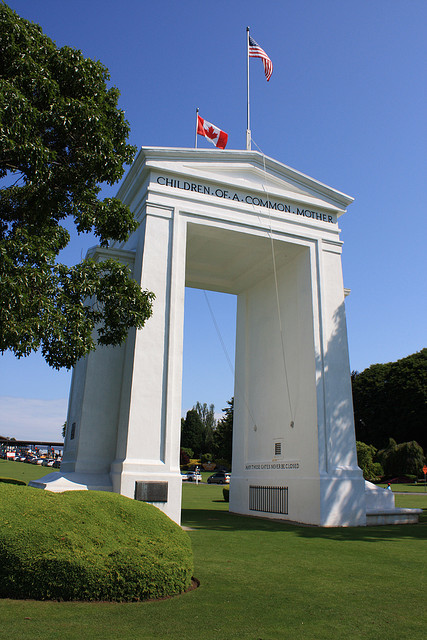Research by Jane Harvey
To understand how money corrupts democracy in the United States, especially in the Northwest states, look north to Canada. What you’ll see is that campaign fundraising is radically different on the two sides of the 49th parallel. It hasn’t always been, but it is now. The differences, and how they developed, reveal just how profound the impacts of US Supreme Court rulings have been on the systemic corruption of politics.
On the south side, elected officials spend their lives dialing for dollars. Citizens United and related Supreme Court cases reign: corporations are persons; money is speech; and the only kind of corruption that’s illegal is the kind that actually involves buying votes with money. Candidates spend without limits, as do “independent expenditure” (IE) campaigns such as those orchestrated by super-PACs. Individual contributions to campaigns are putatively restricted, but any fundraising chair worth her salt can find a way to launder funds through back channels. Individual and corporate contributions to IEs are utterly unrestricted, can sometimes be done anonymously, and IEs are not really independent anyway. Almost every political dollar comes from private donors, often from lobbyists; public funding is isolated in a few outposts of good-government zeal such as Connecticut and Maine. Finally, campaigns can and do run for months on end, laying siege to swing voters and blitzing them with television ads.
On the north side, politicians spend their lives talking with voters and governing. They almost never dial for dollars, er, loonies. A recent legislative leader of one of BC’s political parties reports that he focused time and energy on fundraising about twice a week when he was leader. He didn’t dial for dollars. Compare that to spending half of each day on it, as many American politicians do. Fundraising used to be even less time-consuming. A former premier of British Columbia who spent 24 years in elective office reports spending almost no time raising money; his party raised some but he wasn’t much involved. A former member of the Canadian parliament tells much the same story: a group of volunteers raised some money for his campaign, but he personally spent his campaign time, well, campaigning. One former city councilor in Vancouver remembers raising just $10,000 total (a rounding error in an American campaign) for each of his races. He says he never raised a single dollar, not one, outside of campaign season.
Limit/No Limit

The north-south differences are not cultural but legal. In Canada, federal and provincial authorities tightly limit the amount of money political campaigns can spend; in the United States, SCOTUS says spending limits are unconstitutional, a violation of freedom of speech. A candidate for the Canadian parliament in 2011 was forbidden to spend more than prescribed amounts determined by the population of his or her riding, or district. In the most populous riding, for example, the cap was $134,352. Candidates from the five main political parties actually spent just $36,000, on average, according to data from Elections Canada. Even if you exclude noncompetitive candidates, those who raised less than $2,500, the average only rises to $45,000.
In 2012 US House races, the average expenditures by winning candidates was $1.7 million. That’s 50 times more than their Canadian counterparts. Adjusted for the larger population of US districts, it’s in excess of eight times more. Meanwhile, the maximum spent by a candidate for the US House was John Boehner’s $21 million—157 times what he would have been allowed to spend in Canada.
In BC’s 2013 General Elections, candidates’ budgets were similarly constrained. The limit was $73,218 during the one-month provincial campaign (and the average major-party BC legislative candidate spent just $37,000). In Washington, the average legislative campaign spent $87,000 in 2012: the Washington average exceeded the BC maximum.
Political parties play a bigger role in Canadian campaigns and fundraising than they do in the United States, where candidates are more like free agents. Canadian parties therefore corral a larger share of political dollars than do American parties. Still, Canadian parties’ spending is capped. So even if you combine party dollars with contributions to individual campaigns and throw in independent expenditures too, BC political spending is still a fraction of comparable political spending in the Northwest states.
Total political outlays in 2013’s provincial elections was $28 million, just 36 percent of what it would have been at Washington State rates, adjusted for population. British Columbian provincial-level political spending amounted to $6.10 per BC resident that year, while comparable spending in Washington in 2012 came to $16.57. (Municipal elections in British Columbia are the notable exception, and campaign money has begun to surge into local races, including a single gift of nearly $1 million in the 2011 Vancouver elections.)
Public/Private
The difference extends beyond spending caps, though. The source of the money is different too. Canada provides tax credits for political contributions: some 75 percent of the first $400 you give will come back to you in your taxes. You get diminishing portions of additional donations, until your tax credit tops out at $650 per person per year. With so much of your political giving returning to you at tax time, you’re more inclined to give, and parties and candidates have every incentive to seek grassroots support.
Much Canadian campaign money, furthermore, comes from other public sources—subsidies to political parties and candidates. Such public support for political parties is declining in Canada, as the country’s ruling Conservative Party leadership tries to lock in the political advantage that accrues to it from its edge in private fundraising. Yet even in diminished form, Canadian public funding remains a Niagara compared to the US trickle.

Private contributions to federal campaigns (although not to BC provincial or municipal campaigns) are capped as well, in Canada, so no individual donor can dominate a candidate’s roster. Candidates also have little fear of getting Swift Boated by negative ad buys, Super-PAC style. In Canada, such third-party efforts are regulated closely, at least during campaign season. In provincial races in British Columbia, for example, independent groups were allowed in the last elections to spend no more than $3,138 per riding during the campaign. That’s not even enough money to produce a respectable TV spot, much less broadcast it.
Finally, because of its parliamentary system of government, in which elections are only tentatively scheduled and are not launched until the governing party dissolves parliament (or the provincial legislative assembly), Canada has short campaigns, typically lasting two months or less. Most campaign spending is only permitted during the campaign itself. So the year-long siege of campaign advertising that assaults Americans is something most Canadians are only familiar with if they watch American television.
Not that American-style smear campaigns are unknown in the Great White North. Supporters of conservative and center-right parties in Canada have begun making out-of-season ad buys to bloody their rivals. Before the 2013 campaign season officially began in British Columbia, for example, independent groups spent $1.5 million tarring the center-left New Democratic party with a stink bomb of negative ads. Still, the scale of such nastiness remains modest, by US standards.
Campaigning in Canada is not like civics class, of course. Candidates run deceptive ads and bend the rules and sometimes propagate lies. Commentators routinely refer to politics in Canada as a “blood sport”—the manners in parliamentary debates make Congress seem like Sunday school. (Seriously, watch a little of the link! If C-Span were like that, it might no longer be an effective sleep aid.) Local and provincial rules about campaign money in British Columbia would benefit from adopting some of the rules of Canadian federal elections: capping spending in local races, for example; ending corporate and union gifts to parties in provincial ones; and limiting political attack ads outside of campaign time.
Still, where the systemic corruption of democracy by political money is concerned, Canada is a different world. The fundamental differences are that campaign spending is capped north of the border and uncapped south, and most money is public north and private south. Consequently, politicians spend far less of their time fundraising in the north and are therefore less immersed in the views and preferences of the rich—and more immersed in the views of ordinary citizens.
Parting Ways in 1976
The stark contrast between the United States and Canada is relatively new. Canada’s tough caps on spending, system of public funding, and many other rules date to the Canada Elections Act of 1974. The same year, in the wake of Watergate, Congress made sweeping amendments to the Federal Election Campaign Act (FECA), capping campaign spending and contributions, providing public funding for presidential races, and implementing several other features also found in the Canada Elections Act.

What happened next, in 1976, has made all the difference. The US Supreme Court, in Buckley v. Valeo, hacked big parts out of FECA. In particular, it threw out spending caps on campaigns and independent expenditures—the heart of the law and of the Canadian system. What was left was not so much half a loaf, which is good for something, as half of a brake, which is worthless. Chief Justice Burger, dissenting in Buckley, wrote, “By dissecting the Act bit by bit, and casting off vital parts, the Court fails to recognize that the whole of this Act is greater than the sum of its parts. . . . what remains after today’s holding leaves no more than a shadow of what Congress contemplated. I question whether the residue leaves a workable program.”
Buckley and the absence of any similar ruling in Canada reflect a key difference in the countries’ legal doctrines. In the United States, First Amendment case law has increasingly characterized political speech as an unqualified right. After all, the First Amendment is uncompromising, saying in part, “Congress shall make no law . . . abridging the freedom of speech.” On the other hand, the section on political expression in the Canadian Charter of Rights and Freedoms explicitly provides for “reasonable limits prescribed by law as can be demonstrably justified in a free and democratic society.” This phrasing has left the Canadian Supreme Court reluctant to curtail Canadian campaign finance regulation. In Harper v. Canada, the Court’s majority explained that the model of Canadian electoral politics set out by Parliament “is premised on the notion that individuals should have an equal opportunity to participate in the electoral process. Under this model, wealth is the main obstacle to equal participation.” Tell that to the Roberts court!
Unable to limit political money at the spigot of campaign spending, reformers in US legislative bodies—from Congress to the states to localities—are left trying to limit its origins, neutralize its corrupting influence by making gifts transparent to all, or dilute it with public funds. They impose limits on contributions, knowing that fundraisers will often find ways to circumvent them. They impose strict requirements for disclosure of all contributions, which is better than nothing but has the unfortunate side effect of relentlessly reminding voters of just how much money rich people and corporations spend on politicians. Above all, they try to win public funding for campaigns so that private money won’t matter much.
So far, though, they’ve had only partial and fleeting success. Justice Burger’s fears have been warranted: the rules of money in politics in the Northwest states are “a residue” that does not leave “a workable program.” Next time, I’ll describe those rules.
NOTES: BC’s $6.10 per resident and Washington’s $16.57 from data Sightline gathered. Washington data came from the database at followthemoney.org for 2012 statewide executive races, legislative races, and state court judgeships, political parties, and independent expenditures on these types of races. BC data came from the ElectionsBC’s general election report. We included party and candidate spending on provincial races plus third-party advertising spending on those races.
Thanks to the half dozen students of—and veterans of—Canadian politics who reviewed an earlier version of this article.


Comments are closed.